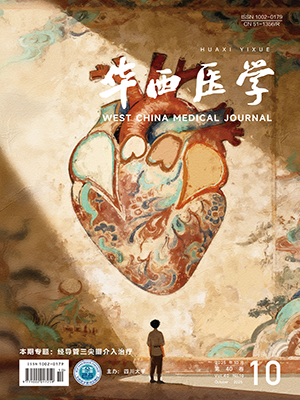| 1. |
龙涛, 彭超, 何智勇, 等. 机器人辅助下经皮骶髂螺钉固定手术的优势及安全性研究. 中华创伤骨科杂志, 2019, 21(1): 10-15.
|
| 2. |
Tile M. Pelvic ring fractures: should they be fixed?. J Bone Joint Surg Br, 1988, 70(1): 1-12.
|
| 3. |
Santoro G, Braidotti P, Gregori F, et al. Traumatic sacral fractures: navigation technique in instrumented stabilization. World Neurosurg, 2019, 131: 399-407.
|
| 4. |
Eastman JG, Kuehn RJ, Chip Routt ML Jr. Useful intraoperative technique for percutaneous stabilization of bilateral posterior pelvic ring injuries. J Orthop Trauma, 2018, 32(5): e191-e197.
|
| 5. |
郭晓山. 骨盆骨折微创手术的问题及展望. 中华创伤骨科杂志, 2019, 21(1): 90-92.
|
| 6. |
Cai L, Zhang Y, Zheng W, et al. A novel percutaneous crossed screws fixation in treatment of day type Ⅱ crescent fracture-dislocation: a finite element analysis. J Orthop Translat, 2019, 20: 37-46.
|
| 7. |
Mirkovic S, Abitbol JJ, Steinman J, et al. Anatomic consideration for sacral screw placement. Spine (Phila Pa 1976). 1991, 16(Suppl 6): S289-S294.
|
| 8. |
Hoernschemeyer DG, Pashuck TD, Pfeiffer FM. Analysis of the S2 alar-iliac screw as compared with the traditional iliac screw: does it increase stability with sacroiliac fixation of the spine?. Spine J, 2017, 17(6): 875-879.
|
| 9. |
师述昌, 朱罡, 王豫, 等. 计算机辅助骶髂关节螺钉最优通道自动规划技术研究. 北京生物医学工程, 2018, 37(6): 551-558, 565.
|
| 10. |
王刚, 张月雷, 章乐成, 等. 骨科机器人联合骨盆解锁复位架辅助下经皮螺钉固定治疗骨盆骨折. 中华创伤骨科杂志, 2020, 22(6): 475-481.
|
| 11. |
Majeed SA. Grading the outcome of pelvic fractures. J Bone Joint Surg Br, 1989, 71(2): 304-306.
|
| 12. |
Matta JM, Saucedo T. Internal fixation of pelvic ring fractures. Clin Orthop Relat Res, 1989(242): 83-97.
|
| 13. |
Mendel T, Radetzki F, Wohlrab D, et al. CT-based 3-D visualisation of secure bone corridors and optimal trajectories for sacroiliac screws. Injury, 2013, 44(7): 957-963.
|
| 14. |
王祎, 张立峰, 王斌, 等. 骶髂关节螺钉新型辅助置钉技术的研究进展. 中华创伤骨科杂志, 2020, 22(6): 507-511.
|
| 15. |
Matityahu A, Kahler D, Krettek C, et al. Three-dimensional navigation is more accurate than two-dimensional navigation or conventional fluoroscopy for percutaneous sacroiliac screw fixation in the dysmorphic sacrum: a randomized multicenter study. J Orthop Trauma, 2014, 28(12): 707-710.
|
| 16. |
谭山, 高仕长, 张安维. 经皮骶髂关节螺钉固定变异骶骨的影像学初步研究. 重庆医科大学学报, 2018, 43(10): 1388-1393.
|
| 17. |
Gardner MJ, Morshed S, Nork SE, et al. Quantification of the upper and second sacral segment safe zones in normal and dysmorphic sacra. J Orthop Trauma, 2010, 24(10): 622-629.
|
| 18. |
黄俊锋, 刘黎军, 韩云, 等. 机器人导航定位系统辅助经皮骶髂螺钉治疗骨盆后环不稳定型损伤的临床研究. 中华骨与关节外科杂志, 2020, 13(2): 148-153.
|
| 19. |
韩巍, 张腾, 苏永刚, 等. 天玑®骨科手术机器人辅助经皮固定骶髂螺钉治疗不稳定骨盆后环骨折的临床研究. 北京生物医学工程, 2021, 40(3): 257-262.
|
| 20. |
邓宁, 吴伟坚, 梁国穗. 机器人和计算机辅助骨科手术. 中华创伤骨科杂志, 2005, 7(7): 620-624.
|
| 21. |
Conflitti JM, Graves ML, Chip Routt ML Jr. Radiographic quantification and analysis of dysmorphic upper sacral osseous anatomy and associated iliosacral screw insertions. J Orthop Trauma, 2010, 24(10): 630-636.
|
| 22. |
Wu XB, Wang JQ, Sun X, et al. Guidance for the treatment of femoral neck fracture with precise minimally invasive internal fixation based on the orthopaedic surgery robot positioning system. Orthop Surg, 2019, 11(3): 335-340.
|




